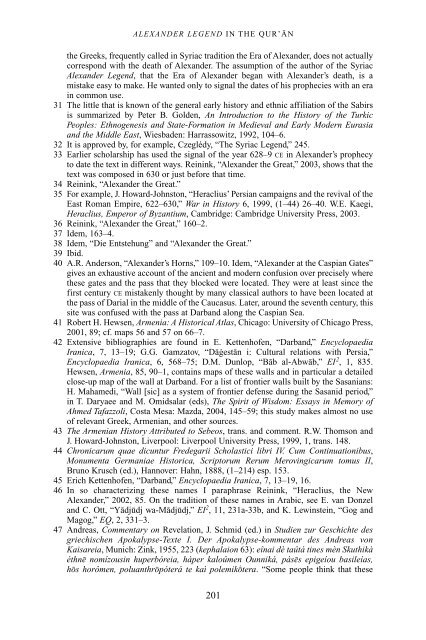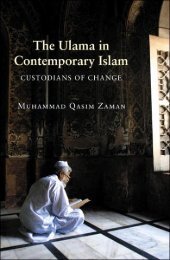The Qur'an in its historical context (pdf - Islam and Christian-Muslim ...
The Qur'an in its historical context (pdf - Islam and Christian-Muslim ...
The Qur'an in its historical context (pdf - Islam and Christian-Muslim ...
Create successful ePaper yourself
Turn your PDF publications into a flip-book with our unique Google optimized e-Paper software.
ALEXANDER LEGEND IN THE QUR’AN<br />
the Greeks, frequently called <strong>in</strong> Syriac tradition the Era of Alex<strong>and</strong>er, does not actually<br />
correspond with the death of Alex<strong>and</strong>er. <strong>The</strong> assumption of the author of the Syriac<br />
Alex<strong>and</strong>er Legend, that the Era of Alex<strong>and</strong>er began with Alex<strong>and</strong>er’s death, is a<br />
mistake easy to make. He wanted only to signal the dates of his prophecies with an era<br />
<strong>in</strong> common use.<br />
31 <strong>The</strong> little that is known of the general early history <strong>and</strong> ethnic affiliation of the Sabirs<br />
is summarized by Peter B. Golden, An Introduction to the History of the Turkic<br />
Peoples: Ethnogenesis <strong>and</strong> State-Formation <strong>in</strong> Medieval <strong>and</strong> Early Modern Eurasia<br />
<strong>and</strong> the Middle East, Wiesbaden: Harrassowitz, 1992, 104–6.<br />
32 It is approved by, for example, Czeglédy, “<strong>The</strong> Syriac Legend,” 245.<br />
33 Earlier scholarship has used the signal of the year 628–9 CE <strong>in</strong> Alex<strong>and</strong>er’s prophecy<br />
to date the text <strong>in</strong> different ways. Re<strong>in</strong><strong>in</strong>k, “Alex<strong>and</strong>er the Great,” 2003, shows that the<br />
text was composed <strong>in</strong> 630 or just before that time.<br />
34 Re<strong>in</strong><strong>in</strong>k, “Alex<strong>and</strong>er the Great.”<br />
35 For example, J. Howard-Johnston, “Heraclius’ Persian campaigns <strong>and</strong> the revival of the<br />
East Roman Empire, 622–630,” War <strong>in</strong> History 6, 1999, (1–44) 26–40. W.E. Kaegi,<br />
Heraclius, Emperor of Byzantium, Cambridge: Cambridge University Press, 2003.<br />
36 Re<strong>in</strong><strong>in</strong>k, “Alex<strong>and</strong>er the Great,” 160–2.<br />
37 Idem, 163–4.<br />
38 Idem, “Die Entstehung” <strong>and</strong> “Alex<strong>and</strong>er the Great.”<br />
39 Ibid.<br />
40 A.R. Anderson, “Alex<strong>and</strong>er’s Horns,” 109–10. Idem, “Alex<strong>and</strong>er at the Caspian Gates”<br />
gives an exhaustive account of the ancient <strong>and</strong> modern confusion over precisely where<br />
these gates <strong>and</strong> the pass that they blocked were located. <strong>The</strong>y were at least s<strong>in</strong>ce the<br />
first century CE mistakenly thought by many classical authors to have been located at<br />
the pass of Darial <strong>in</strong> the middle of the Caucasus. Later, around the seventh century, this<br />
site was confused with the pass at Darb<strong>and</strong> along the Caspian Sea.<br />
41 Robert H. Hewsen, Armenia: A Historical Atlas, Chicago: University of Chicago Press,<br />
2001, 89; cf. maps 56 <strong>and</strong> 57 on 66–7.<br />
42 Extensive bibliographies are found <strong>in</strong> E. Kettenhofen, “Darb<strong>and</strong>,” Encyclopaedia<br />
Iranica, 7, 13–19; G.G. Gamzatov, “Da∫estan i: Cultural relations with Persia,”<br />
Encyclopaedia Iranica, 6, 568–75; D.M. Dunlop, “Bab al-Abwab,” EI 2 , 1, 835.<br />
Hewsen, Armenia, 85, 90–1, conta<strong>in</strong>s maps of these walls <strong>and</strong> <strong>in</strong> particular a detailed<br />
close-up map of the wall at Darb<strong>and</strong>. For a list of frontier walls built by the Sasanians:<br />
H. Mahamedi, “Wall [sic] as a system of frontier defense dur<strong>in</strong>g the Sasanid period,”<br />
<strong>in</strong> T. Daryaee <strong>and</strong> M. Omidsalar (eds), <strong>The</strong> Spirit of Wisdom: Essays <strong>in</strong> Memory of<br />
Ahmed Tafazzoli, Costa Mesa: Mazda, 2004, 145–59; this study makes almost no use<br />
of relevant Greek, Armenian, <strong>and</strong> other sources.<br />
43 <strong>The</strong> Armenian History Attributed to Sebeos, trans. <strong>and</strong> comment. R.W. Thomson <strong>and</strong><br />
J. Howard-Johnston, Liverpool: Liverpool University Press, 1999, 1, trans. 148.<br />
44 Chronicarum quae dicuntur Fredegarii Scholastici libri IV. Cum Cont<strong>in</strong>uationibus,<br />
Monumenta Germaniae Historica, Scriptorum Rerum Merov<strong>in</strong>gicarum tomus II,<br />
Bruno Krusch (ed.), Hannover: Hahn, 1888, (1–214) esp. 153.<br />
45 Erich Kettenhofen, “Darb<strong>and</strong>,” Encyclopaedia Iranica, 7, 13–19, 16.<br />
46 In so characteriz<strong>in</strong>g these names I paraphrase Re<strong>in</strong><strong>in</strong>k, “Heraclius, the New<br />
Alex<strong>and</strong>er,” 2002, 85. On the tradition of these names <strong>in</strong> Arabic, see E. van Donzel<br />
<strong>and</strong> C. Ott, “Yadjudj wa-Madjudj,” EI 2 , 11, 231a-33b, <strong>and</strong> K. Lew<strong>in</strong>ste<strong>in</strong>, “Gog <strong>and</strong><br />
Magog,” EQ, 2, 331–3.<br />
47 Andreas, Commentary on Revelation, J. Schmid (ed.) <strong>in</strong> Studien zur Geschichte des<br />
griechischen Apokalypse-Texte I. Der Apokalypse-kommentar des Andreas von<br />
Kaisareia, Munich: Z<strong>in</strong>k, 1955, 223 (kephalaion 63): eînai dè taûtá t<strong>in</strong>es mèn Skuthikà<br />
éthne nomízous<strong>in</strong> huperbóreia, háper kaloûmen Ounniká, páses epigeíou basileías,<br />
hos horômen, poluanthropóterá te kaì polemikótera. “Some people th<strong>in</strong>k that these<br />
201



